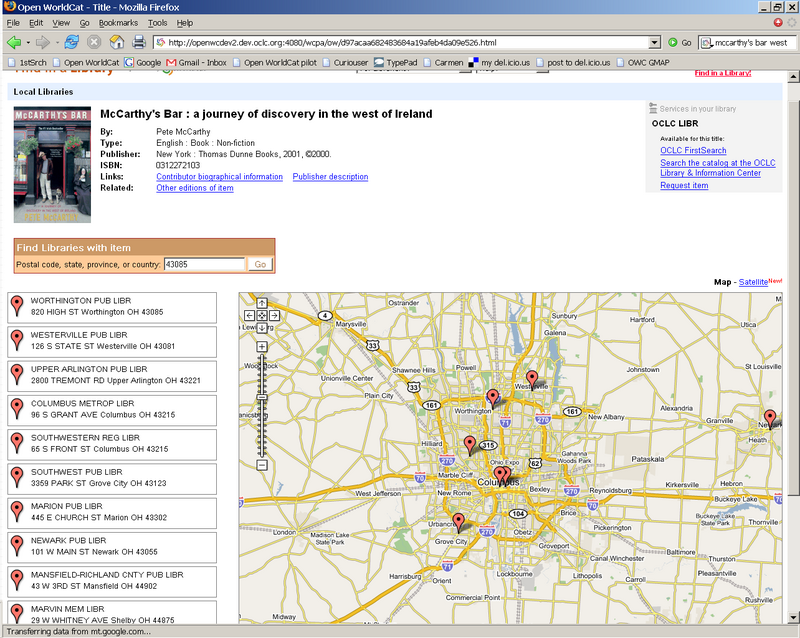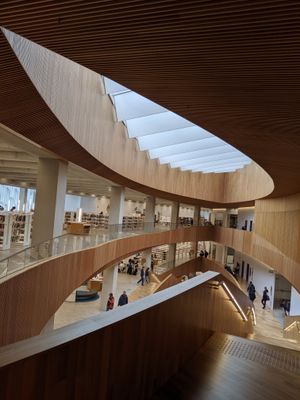 Thom previews Mike Teets’ library mapping demo on the evolving Product works page. This page will be enhanced in coming weeks to showcase various of the ongoing initiatives which will find their way into OCLC services.
Thom previews Mike Teets’ library mapping demo on the evolving Product works page. This page will be enhanced in coming weeks to showcase various of the ongoing initiatives which will find their way into OCLC services.
Google Maps seems to have sparked a growing interest in location-based services, partly because it has opened its interface allowing others to build applications on top of it. Here are a couple of links to discussions of libraries and locations.
- Peter Brantley draws attention to the O’Reilly Where 2.0 conference, and speculates about location-based services in the information space.
- Paul Miller has been writing extensively about this in recent months. See here and here for example.
Paul talks about leveraging third-party services, and Thom about loose coupling.
What we are looking at here are ‘platform’ services, using ‘platform’ in a Web 2.0 sort of way. In this sense, a platform is a resource which makes services available through machine interfaces. Others build applications drawing on platform services through APIs/web services. Amazon, Google and eBay are major platform service providers.
This suggests a rather simple model of ‘horizontal’ platform providers whose services may be consumed by many ‘vertical’ application builders.
Now, clearly cataloging and resource sharing have some of the characteristics of ‘platform’ services, even though they are not always consumed through machine interfaces. Indeed, one reason why libraries were very early developers of protocols and exchange formats was that libraries, and their system vendors, were building applications on top of data and services from elsewhere. Structurally, union catalog organizations are arose to provide an early form of shared service for libraries. In fact utility is a very platform-like word, and the motivation that is currently driving platform services is very similar to that which drove library resource sharing organizatoins. This might be summarised as developing shared services to remove redundancy and build capacity.
And indeed, OCLC and other organizations in our space are considering what it means to be a ‘platform’ provider. Experimental and trial services like xISBN and terminology services indicate a direction. As do the construction of registry services for library catalogs and OpenURL resolvers. As does the further development of machine interfaces to other service areas. The Talis Silkworm initiative is explicitly positioned as a ‘horizontal’ platform play in an environment of ‘vertical’ ILS application builders. Interestingly, Talis began life as a shared cataloging service in 1969 and continues to provide that service around its union catalog. And the work of Peter Brantley and colleagues at the California Digital Library also has a ‘platform’ flavor about it, as they build ‘horizontal’ infrastructure services for the UC libraries. Of course, CDL provides the union catalog Melvyl. Paul Miller works for the Common Information Environment, one of whose aims is to ensure that UK public sector organizations who are developing information systems do so in ways which avoid unecessarily redundant platform development through a common appreciaton of shared services.
This aligmnent of ‘horizontal’ and ‘vertical’ services will be one of the most interesting things to watch over coming years in the library space. My view is that one of the major changes we will see is that more operations are moved into horizontal ‘shared services’ so that libraries can concentrate on creating value in their vertical, user-oriented services. These ‘horizontal’ services may not start out as ‘platform’ services in the sense that they are made available through web services and can be stitched recombinantly into other applications. However they will move in that direction.
Libraries and the system vendors which serve them cannot afford to build the full range of services which will be needed to meet user expectations and service ambitions moving forward. Think of virtual reference, repository infrastructure, recommender systems, metadata creation, exposure to search engines, directory and registry services, knowledge bases, selective web harvesting and preservation, aggregated repositories of open access and other materials. The list could be extended considerably. This is one reason why I think that some of the most interesting questions facing libraries are organizational: what organizational frameworks will best secure these services, and what will be the balance between local and shared or third-party activity?



